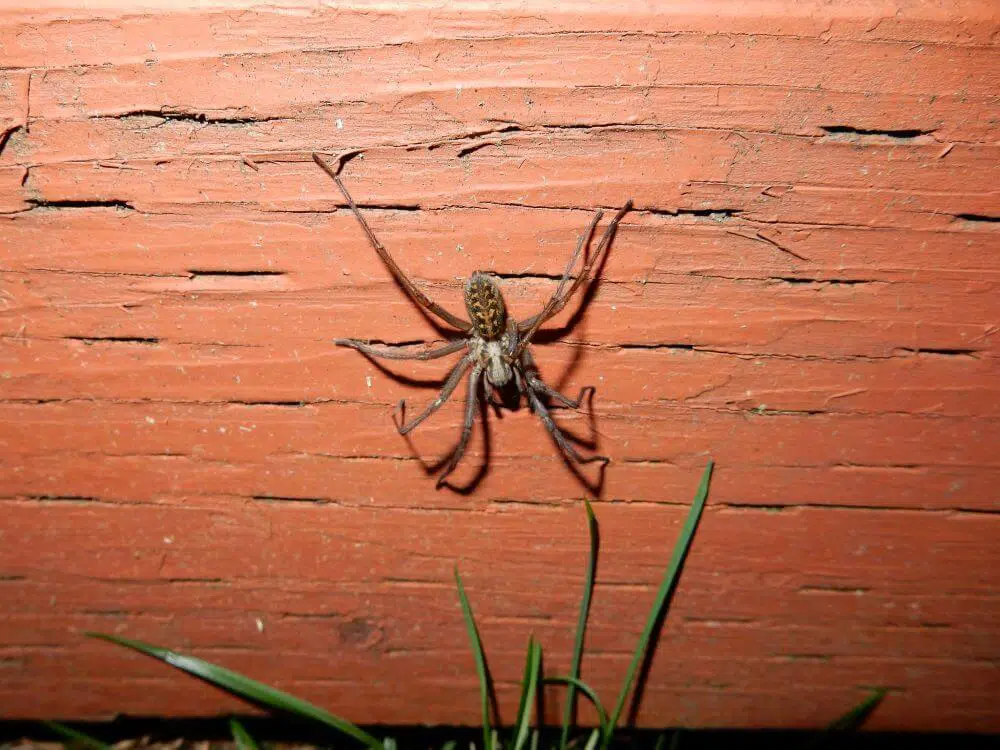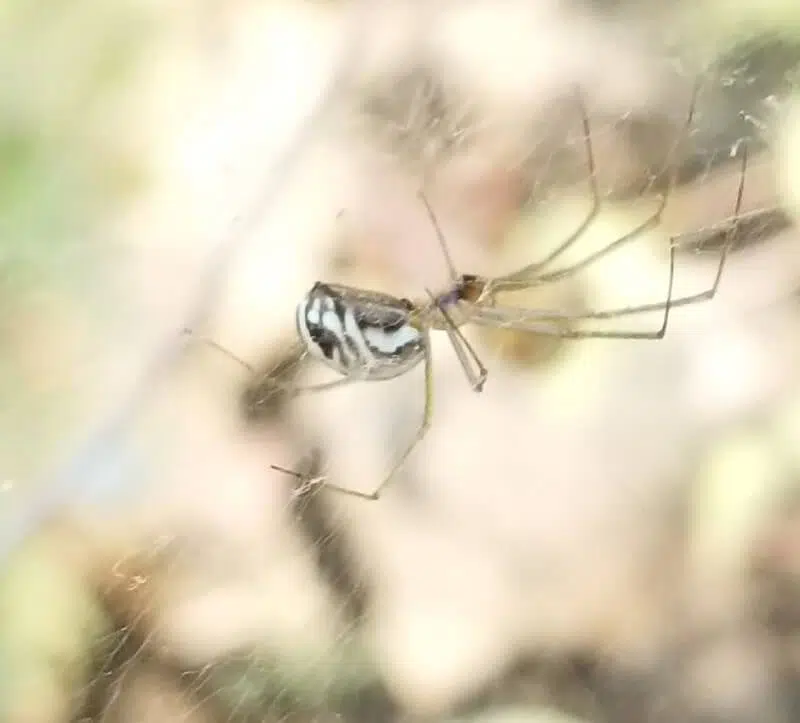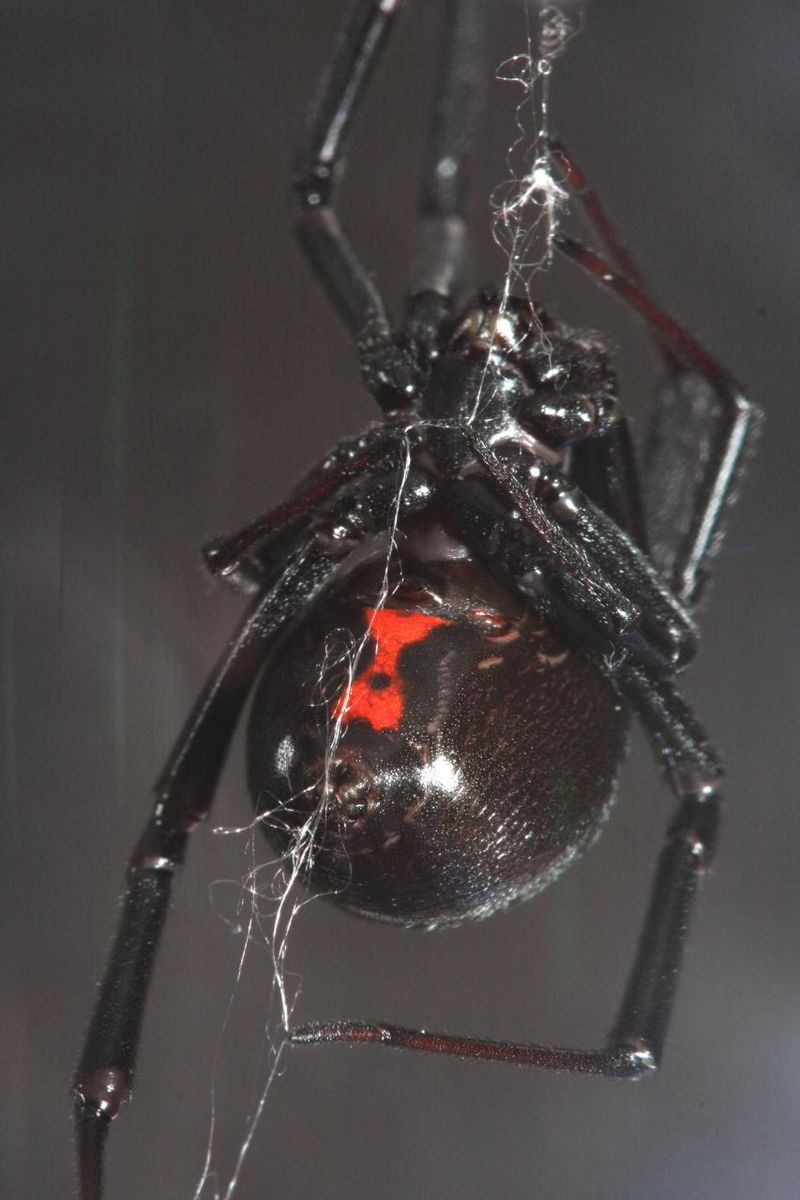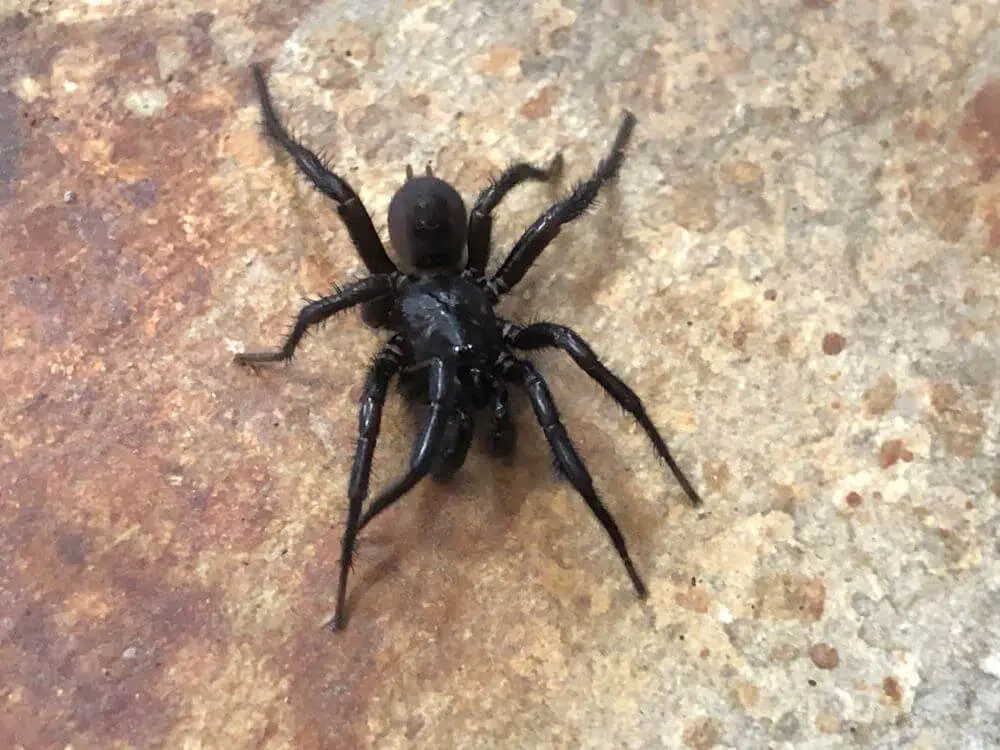More than nine hundred and fifty documented spider species call Washington their home. While all spiders have venom, they are not all harmful to humans.
Knowing and identifying the different Washington spiders can help you determine if the bite you have is a medical emergency. Of course, we are not going to list all the spiders you may encounter in Washington, but the most common from the most popular to the least popular.
Table of Contents
Are There Venomous Spiders In Washington?
Spiders are not aggressive and will usually try and escape rather than bite. Bites occur when they are trapped or disturbed. The venomous spiders include:
- Western Black Widow – a medical emergency with neurotoxic venom which can cause sweating, nausea, and muscle rigidity
- Yellow Sac Spider – redness, swelling, and burning. Some people experience nausea, vomiting, and headaches
- False Black Widow – not very potent, but a bite can cause pain that radiates from the bite, lasting up to twenty-four hours.
27 Common Spiders In Washington
The common spiders you may encounter in Washington include:
1. Cross Orbweaver

Scientific name: Araneus diadematus
Common name: European garden spider, diadem spider, orangie, cross spider, crowned orb weaver, pumpkin spider
The cross orbweaver is originally from Europe and was transported to North America, where it has settled in well. It has a dark brown abdomen with a white cross marking. The female is double the size of the male. They have hairs on their legs with brown and tan banding and white hairs on the cephalothorax. The white cross on the back is white dots and dashes.
The spider sits upside down in the center of a large circular-shaped web, when startled the spider drops to the ground and hides. The cross orbweaver can be found in woodlands, semi-arid deserts, evergreen forests, gardens, meadows, and grasslands.
2. Giant House Spider

Scientific name: Eratigena duellica.
Common name: giant house spider.
Giant house spiders are dark brown with a light marking on the sternum and three spots on the side that form an arrow pointing towers the spider’s head. Their palps, abdomen, and legs are hairy.
Females can grow to 0.73 inches (18.5mm) in body length and males grow to around 0.59 inches (15mm) in body length. Their leg span can vary up to 2.95 inches (75mm).
Their eight eyes are arranged in two rows of equal size.
They built messy and flat webs with a funnel at the end, which is not sticky. The spider hides in the funnel waiting for insects to get stuck in their web. The spider will run out of the funnel and attack.
Their webs are common in basements, behind furniture, and in corners of floors and ceilings, they choose areas where they will not be disturbed.
Their venom is designed to subdue pain, though they do bite humans if provoked. Their bites are no worse than a bee sting, which can be managed at home and is not considered a medical emergency.
3. Zebra Jumping Spider

Scientific name: Salticus scenicus.
Common name: zebra jumping spider.
Zebra jumping spiders can grow to 8mm in body length and are common from spring to fall. They are small spiders with black and white markings that are usually observed hunting on outside walls, sometimes making their way indoors to find their next meal.
They are ambush hunters with excellent vision, they hunt by day, ambushing small insects by pouncing on them. Their webs are to store eggs or create a retreat, a safe place to store and eat prey that has been captured.
4. Goldenrod Crab Spider

Scientific name: Misumena vatia.
Common name: goldenrod crab spider, flower (crab) spider.
The goldenrod crab spider is found hunting in goldenrod sprays and milkweed plants. They are known as crab spiders as they can walk forwards, backward, and sideways.
Females are larger than the male, growing to 0.39 inches (10mm), and males growing to 0.20 inches (5mm) in body length.
Their coloration varies from white to yellow, some have a pattern of both colors. These spiders can change color based o their environment, with color changes taking place during molting.
The goldenrod crab spider feeds on common insects and is not afraid to prey on insects considerably larger than themselves. Females tend to remain on one flower, while males wander searching for a mate.
5. Bold Jumping Spider

Scientific name: Phidippus audax.
Common name: daring jumping spider, bold jumping spider.
Bold jumping spiders belong to the Salticidae family and are small jumping spiders with the unique ability to jump large distances. Their jumping helps them ambush prey and escape predators.
They are not easy to catch, but they will bite. Their bites cause a stinging sensation and are not considered dangerous to humans.
The bold jumping spider is bold in color with black and a white line on the upper part of their abdomens with two white dots close to the rear.
They live in just about any habitat from offices and homes to cars. They are mostly active during the day, where they wander and hunt for insects.
6. False Black Widow

Scientific name: Steatoda grossa.
Common name: False black widow, cupboard spider.
The female false black widow can grow to 10.5mm in body length and is dark in color with a bulb-shaped abdomen. Their color ranges from purple-brown to black with lighter markings. The false black widow does not have a bright hourglass on its belly or any bright markings.
Males are more slender than females with similar coloration.
The false black widow creates a cobweb, a tangled mess of sticky silk, and has exceptionally bad eyesight, relying on the vibrations inside their web to locate prey.
They are not aggressive with most human bites being due to the spider getting caught between clothing and the body, pinching or squeezing the spider.
Their bites are considered medically significant with symptoms including blistering on the bite site, pain, fever, muscle spasms, and sweating, which can last several days.
7. Common Candy-striped Spider

Scientific name: Enoplognatha ovata.
Common name: common candy-striped spider.
The common candy-striped spider belongs to the Theridiidae family, native to Europe and introduced to North America.
This spider can grow to 6mm in leg span with translucent legs and a bulb-shaped abdomen that varies in color and pattern. They are white, green, or cream with dark spots, a broad red stripe, or two red stripes, that create a V shape.
They are excellent predators, even though they are small, preying on insects considerably larger than themselves. They are commonly encountered in gardens, grasslands, and hedgerows.
8. Long-bodied Cellar Spider

Scientific name: Pholcus phalangioides
Common name: daddy long-legs spider, long-bodied cellar spider, skull spider.
The long-bodied cellar spider is usually referred to as a daddy long legs, with an elongated and tubular-shaped abdomen and long spindly legs.
Being almost completely blind, the long-bodied cellar spider sits in its web, hanging upside down, waiting for insects to get entangled.
They have exceptionally small mouthparts and cannot bite humans.
They are known to bounce in their webs, making themselves blurred to predators, it is also believed to make the web blurred to prey, helping them get accidentally entangled.
9. Mouse Spider

Scientific name: Scotophaeus blackwalli.
Common name: mouse spider.
The mouse spider belongs to the Gnaphosidae family and was introduced to North America from Europe, where they are widespread.
They are common both inside and outside of homes, hiding under bark or in holes in walls. They are nocturnal hunters with males growing to 9mm in body length and females reaching 12mm in body length. The carapace or head plate is dark brown with a gray to brown abdomen.
They have hairs that resemble that of a mouse. They also run with a start and stop movement, which is similar to a mouse. The legs are brown. They are not considered medically significant.
10. Common House Spider
Scientific name: Parasteatoda tepidariorum.
Common name: common house spider, American house spider.
The common house spider creates the Halloween web, a tangled mess that you find in the corner of windows or attics. It is not that uncommon for females to have webs close to one another.
They are comb-footed spiders with long legs and comb-like hairs on the back ankles. They fling a silk strand at insects that get entangled in their webs. Victims are then bitten and eaten later. They can remain still for long periods, which helps them avoid being seen by insects and humans.
The common house spider has a bulb-shaped abdomen and is brown with specks of white and dark lines and patches. They are small spiders and do not bother humans, they are not aggressive and often play dead when threatened. They can bite but are not considered dangerous to humans.
11. Johnson’s Jumping Spider

Scientific name: Phidippus johnsoni.
Common name: red-backed jumping spider, Johnson’s jumping spider.
The Johnson’s jumping spider is a small spider that can jump more than five times its body length. They do not create webs to capture prey, they are wandering predators that ambush their prey with their rapid-fire jumping, pouncing on prey and biting them, injecting venom into the prey.
The spider then carries the prey back to the web they create as a retreat, a place to hide, eat and store food. They hunt during the day and are known to give a painful bite, though it is not dangerous and is not considered a medical emergency.
12. Sierra Dome Spider

Scientific name: Neriene litigiosa.
Common name: sierra dome spider.
Sierra dome spiders produce dome-shaped webs that hang between bushes and at wood edges.
Females sit upside down beneath the dome. Females are known to mate with more than one male. Females seldom leave their web, while males are seen as they search for a mate, hanging out on a branch or the side of their web.
All encounters with thee spiders have been outdoors with the spider inside its web.
13. California Flattened Jumping Spider

Scientific name: Platycryptus californicus.
Common name: California flattened jumping spider.
The California flattened jumping spider belongs to the Salticidae family and is known for jumping considerable lengths for its small size.
These black spiders have brown and white on their cephalothorax and mostly white markings on their elongated abdomens, which are also covered in fine hair. Their legs have black, brown, and white banding and are also hairy.
With their ability to jump considerably lengths, they can easily ambush and pounce on unsuspecting prey. Their webs are used as a retreat. These spiders hunt during the day, returning and hiding in their retreat at night.
14. Eurasian Running Crab Spider

Scientific name: Philodromus dispar.
Common name: Eurasian running crab spider.
The Eurasian running crab spider is commonly encountered in bushes and trees. They are agile hunters with females varying in color and size. The males are shiny and black or dark brown with white edging. They grow to 5mm in body length and feed mostly on flies and small insects.
They hunt their prey like a cat, they remain still and then ambush when the prey comes near.
15. Northern Yellow Sac Spider

Scientific name: Cheiracanthium mildei.
Common name: Northern yellow sac spider.
The Northern yellow sac spider is green or tan with dark brown chelicerae and palpi. They grow to around 0.4 inches (10mm) in body length and their legs end in a double claw with the front pair being longer than the other legs.
Yellow sac spiders are native to North Africa and Europe and were introduced to the United States. They are usually found inside homes and outside.
These are venomous spiders, as with all spiders. Their bites are usually restricted to the bite site and the first symptoms appear up to eight hours after being bitten. The bite may not remain restricted to the bite area.
Usually, the bite resembles a mosquito bite, but it becomes painful and swollen. It can ulcerate into a large lesion of up to 10cm and will require medical attention. Bites can take up to four weeks to heal and lesions can take months to heal.
16. Western Black Widow

Scientific name: Latrodectus hesperus.
Common name: western black widow, western widow.
The Western black widow is a venomous spider with females being the most dangerous, growing to 16mm in body length.
Females are black with a red hourglass marking on the belly. The hourglass can be white or yellow. Males are only half the size of a female and tan in color with stripes on their abdomen. They create messy and tangled webs.
The female black widow has a powerful venom that contains neurotoxins. Symptoms can range from pain and goosebumps to sweating and pain.
Fatalities around the world are reported to between 0.5% and 12%, though the most recent studies have not found any fatalities in North America from a Western black widow bite.
Further Reading:
17. Silver-sided Sector Spider

Scientific name: Zygiella x-notata.
Common name: missing sector orb weaver, silver-sided sector spider.
The silver-sided sector spider can grow to 1mm in boy length for females and 7mm in body length for males. Their abdomens have a silver sheen.
Females have gray banded legs and dark gray waves o their underside. Males are smaller, with dark undersides and dark brown cephalothorax and legs. Males have a smaller abdomen with a cream.
They are more common from July to October.
18. Grass Spiders

The grass spider is better known as the American grass spider and is a member of the funnel weaver family, known for weaving sheet webs with a funnel shelter on one side. They do not create sticky webs with the spider able to run at a fast pace to capture any insects that come in contact with the web.
They can grow to 19mm in body length with their eight eyes in three rows. They have distinct banding on their legs, along with two dark bands that run both sides of their cephalothorax.
19. Banded Garden Spider

Scientific name: Argiope trifasciata.
Common name: banded garden spider, banded orb weaving spider.
Banded garden spiders are members of the orb weaver family and can create circular-shaped webs up to two feet in diameter. Their web length is determined by the spider’s size with some larger adults weaving webs up to two meters.
Females site upside down in the center of the web with her legs arranged in pairs to make a cross shape. The male is much smaller and creates their small webs, which are usually close to the female’s web.
They can feed n insects larger than themselves, by biting them and injecting their venom, and then covering the prey in silk.
20. Woodlouse Spider

Scientific name: Dysdera crocata.
Common name: woodlouse hunter, sowbug hunter, sowbug killer, pillbug hunter, slater spider.
The female woodlouse spider can grow to 15mm in body length with males being smaller, averaging around 10mm. These spiders have orange or dark red legs and cephalothorax with a shiny yellow/brawn to beige-colored abdomen.
They are found around homes and can be observed under rocks, logs, bricks, and leaf litter, close to woodlice, which is their primary diet. They hide in their silken retreat during the day and hunt at night. They spin their webs at night, a place to hide and eat their prey.
21. Bronze Jumping Spider

Scientific name: Eris militaris.
Common name: bronze jumper or bronze lake jumper.
The bronze jumping spider is common in Washington with the males having a dark-colored cephalothorax and white banding on the sides. Their abdomen is lighter in color with white bands.
Females are lighter on their cephalothorax and darker o the abdomen, they do not have the white bands. Females can grow to 8mm with males growing to 6.7mm in body length.
They are common in homes fields and the woods. They are usually missed their bronze brown coloration helps them blend in with their environment. They can and will bite if provoked, but they are usually as curious about us as we are about them. They usually run and hide if they feel threatened.
22. Grey Cross Spider

Scientific name: Larinioides sclopetarius.
Common name: bridge spider, gray cross spider.
The female gray cross spiders are heavier than the males, but males can be longer in body length. Females can weigh up to 60mg and grow to 6.25mm; males, on the other hand, can weigh up to 38mg and grow up to 7mm in body length.
They have dark markings on their abdomens and white hairs on their heads providing a silhouette. They are usually seen near artificial light sources that attract insects.
The females look for illuminated areas to build their webs and lay their eggs. The larger adult females also occupy the best foraging spots, with juveniles finding themselves with bad feeding areas, as they are still unable to compete for better feeding grounds.
23. Pacific Folding door Spider

Scientific name: Antrodiaetus pacificus.
Common name: Pacific Folding door Spider.
The Pacific folding door spider belongs to the Mygalomorph spider species with males and females first described in 1884. They have a dark brown to black carapace with three patches on their abdomens. Females can grow to 13mm, with the males being smaller at around 11mm.
They make their home in cool and damp forest areas, building burrows in sand, moss, and soft substrates, including decaying wood. They keep the entrance of their burrow closed during the day and open it and wait at night for beetles and other insects to come past.
24. Nordmann’s Orbweaver

Scientific name: Araneus nordmanni.
Common name: Nordmann’s Orbweaver.
The Nordmann’s orbweaver belongs to the Araneidae family and is an orb weaving spider, which means that it can create larger circular webs, usually around two feet in diameter. The female hangs upside down in the center of her web waiting for prey to get entangled.
Their webs can be seen in back yards, gardens, forests, grasslands, and meadows.
25. Hobo Spider

Scientific name: Eratigena agrestis.
Common name: hobo spider.
The hobo spider is a funnel-web spider, which creates funnel-shaped webs, where they lie in wait at the end of the funnel for insects to get entangled. They are known to create their webs inside and outside human homes.
They can grow to 14mm in body length and are brown in color with a chevron pattern on the enter of their abdomen, pointing towards the head. There is also a light stripe that runs down the center of the sternum.
26. Cat-faced Orbweaver

Scientific name: Araneus gemmoides.
Common name: Cat-faced spider, jewel spider.
Cat-faced orb weavers are also known as jewel spiders and are common outdoor spiders that are harmless to humans. They create webs close to artificial light sources, in closed spaces on the side of buildings. They are also found underwood and overhangs.
They vary in color and have two horn-shaped on their abdomen. They change color from winter to summer.
27. Western Spotted Orbweaver

Scientific name: Neoscona oaxacensis.
Common name: western spotted orbweaver, zig-zag spider.
The Western spotted orbweaver is a large spider with females growing to 18mm and males to 13mm in body length. They have a distinctive black and white pattern on their abdomen.
They live in a host of habitats from yards and parks to woods with low vegetation. As with the long-bodied cellar spider, these spiders vibrate in their web when they feel disturbed. They are harmless to humans, usually dropping from the center of the web and hiding until the threat has passed.
Summary
While all spiders in Washington and the world are venomous, their venom is designed to immobilize their prey. Except for the female black widow, most spider bites are no worse than a bee sting, with pain and swelling being localized and healing within a day or two.
If you are unsure of what spider bit you and are experiencing problems breathing or the pain is not localized to the bite area, seek immediate medical attention.
Further Reading: